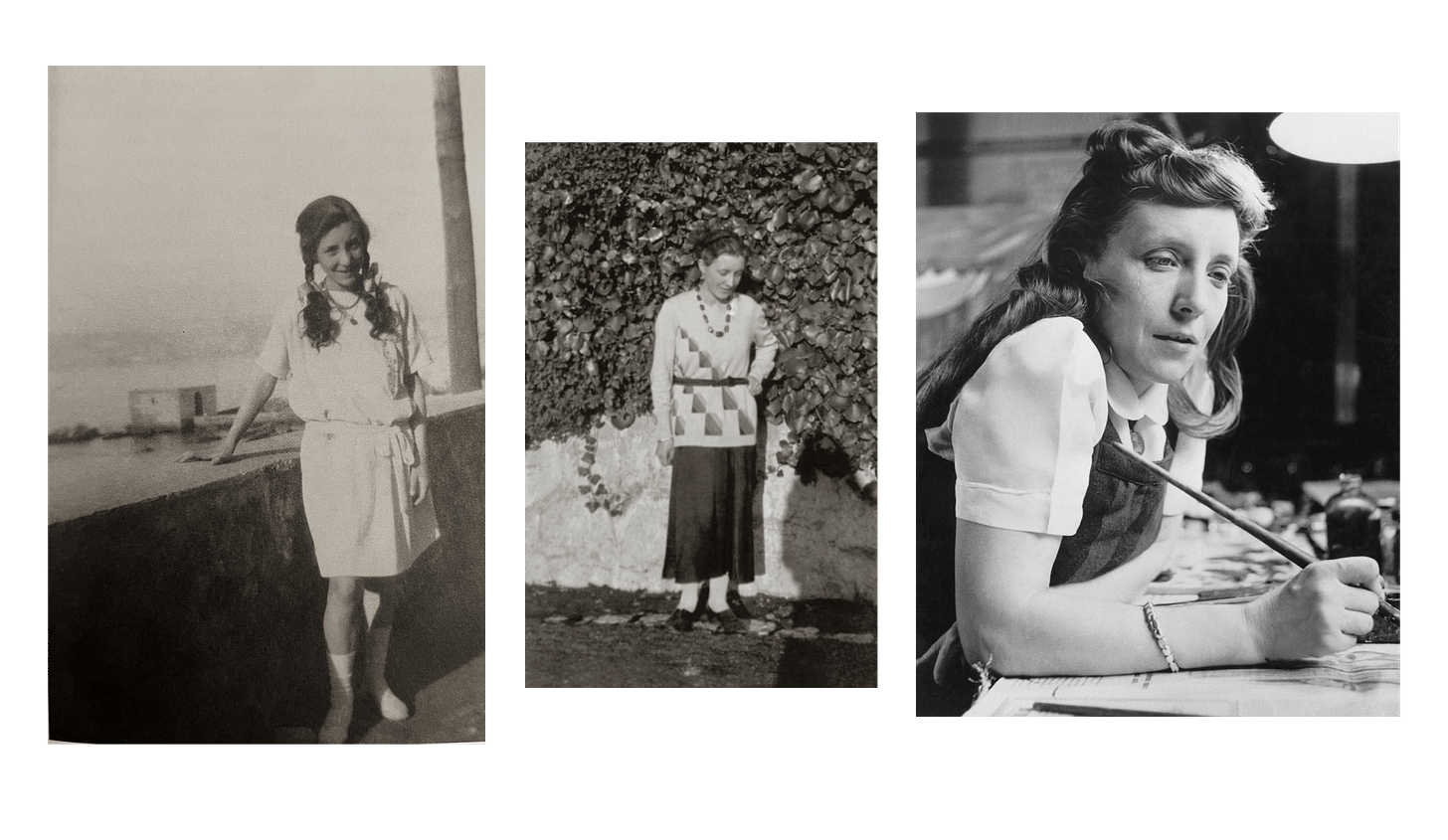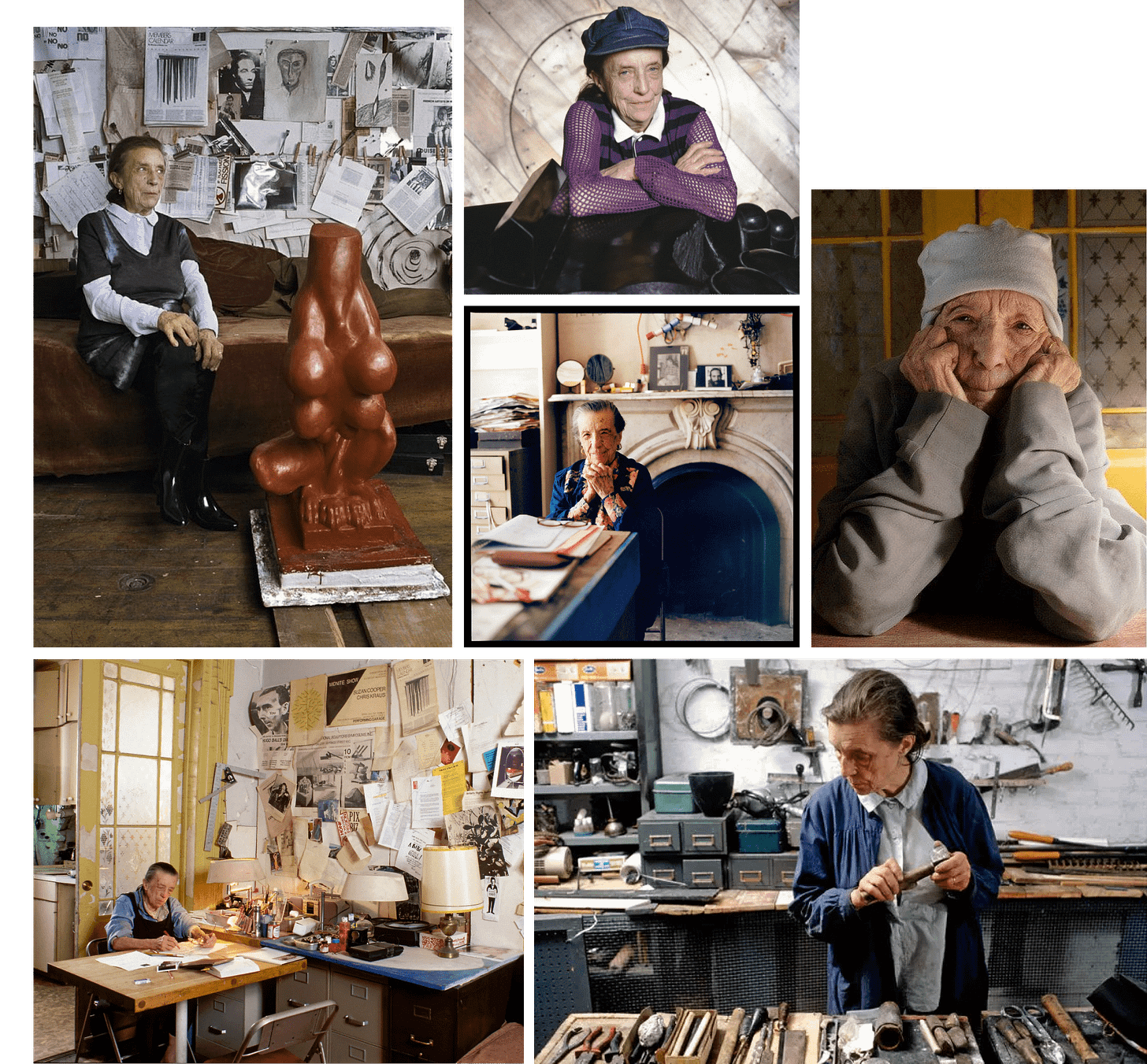Louise Bourgeois' relationship with clothes
Exploring the wardrobe of an artist that transformed her garments into timeless vessels of memory, vulnerability, healing and protection.
You can retell your life and remember your life by the shape, the weight, the color, the smell of the clothes in your closet.
This is the quote by one of the greatest women of 20th century, Louise Bourgeois, and today I want to do exactly what that: study Louise's fashion choices and see how clothing is a theme that goes as a continuous thread through her life and her career as a multidisciplinary artist. Louise once did a catwalk performance, influenced many modern designers and became close friends with some, and dedicated the last twenty years of her life to creating textile art objects with clothes from her household.
Quick note: this post has lots of pictures so it will cut off in email, please read in the Substack app or browser.
Her relationship with clothes started from the early childhood. Repair is what the artist’s family did for a living: they owned a tapestry restoration business and young Louise was exposed to fabrics, their influence and the story they tell:
Stylistically the background is always the extraordinary tapestries with which I grew up. I lived with them since I was born. It has to do with the stories. I am telling the same stories as the tapestries told, but with different means.
From a young age Louise wore designer clothes by Chanel and Poiret, which indicated that her family was relatively well-off and part of the cultural elite in their field. Their financial comfort afforded Louise access to art, education, and intellectual circles from an early age. In her youth, particularly during her time in Paris, her style was sophisticated yet somewhat restrained, she wore simple tailored blouses, dresses and skirts. One outfit that stands out from that era is her Sonia Delaunay sweater: it was a time when Sonia, best known as an abstract painter focused on color theory, was actively designing costumes for cinema and theater and even started her own fashion label.

But as Louise Bourgeois grew older, particularly after moving to the United States and further cementing her role in the art world, her style evolved, becoming more eclectic and individualistic. Louise took great care of her clothes and became deeply attached to them:
It gives me great pleasure to hold on to my clothes, my dresses, my stockings, I have never thrown away a pair of shoes of mine in 20 years. The pretext is that they are still good – it’s my past and as rotten as it was, I would like to take it and hold it tight in my arms.
We can see a proof of that in photos of her wearing the same white sheepskin coat by the Austrian designer and a friend, Helmut Lang, over a span of years:
Louise met Helmut Lang in 1997, shortly after he had moved from Vienna to New York. They quickly formed a close friendship, with Lang later describing their bond in an interview for Charlie Porter’s book What Artists Wear: “I have a very strong emotional and unconditional bond with Louise, maybe because, as she once said herself, we are both runaways.” Porter notes that Bourgeois had other extravagant pieces by Helmut, like an “exquisite and odd” padded knit shawl or a black tufted tuxedo coat that was a sample from Helmut Lang Spring 1999 show. Fur coats were a big part of Louise Bourgeois': she poses in a black “silk feather” one during a Helmut Lang campaign holding Fillette (1968) sculpture in her hands. Helmut and Louise would exchange many sentimental gifts, and Bourgeois even created a metal sculpture of a house with perforated “WE LOVE HELMUT” text through which we see a passing light.

Another coat, this time neon pink and from faux fur, was gifted to Louise by a gallerist Robert Miller in the 90’s and later cut up and turned into seven stuffed pink fur heads by the artists. Pink is a color that she uses a lot in her works: it’s the color of flesh, femininity and emotional vulnerability. The soft, nurturing pink contrasts with the sharp emotional undertones of her pieces, creating tension between comfort and unease.
Another recurring color that dominates both her works and her personal wardrobe is blue, a color of emotional detachment, melancholy and at the same time tranquility. In her personal style, Louise Bourgeois loved layering and often wore a combination of a shirt, cardigan, or sweater in various shades of blue.
In 1995, aged 83, Bourgeois made a significant decision to transfer most of her clothes to her studio, which would lead her to creating mostly textile sculptures for the rest of her life:
The shock came when the truck appeared and a twenty year preserved wardrobe actively left my sight, the cord was cut and I felt dizzy — the history of the wardrobe started.
Clothes were sorted by color and significance: some were later cut into pieces, modified and transformed into completely different objects, and others appeared in her works intact.
A year or two later Louise created a series of installations on blue and pink garments from her childhood (Blue Days (1996), Untitled (1996), Pink Days and Blue Days (1997), clothes hung on a pillar and stuffed as if a human soul is still present inside of them. They look somewhat ghostly and indicate how garments outlive their owners: "Bodies come and go; the clothes that have received those bodies survive” says Peter Stallybrass in his essay Worn Worlds.
Her beloved berets shared the same destiny. Worn frequently in her daily life and during photoshoots, they became part of her identity and later art. In one of her final works, Untitled (2010), Louise stuffed and stitched them together, as if anticipating that she would no longer need those berets as accessories and instead immortalized them.
Talking about accessories, in 1948 Bourgeois designed her own minimalist metal necklace in the form of shackle. We can see young Louise wear it during a lunch with her father. Fifty years later (for an exhibition at the Reina Sofia in Madrid) that necklace was recreated in satin sterling silver in a limited edition of 39 by the artistic jeweler Chus Burés from Madrid. Bourgeois loved the recreation a lot and there even was an idea to do a gold version, but it was too expensive. The necklace featured five holes which could be used to attach additional crystals that could be swapped out and rearranged differently. Later Bourgeois gifted this necklace to Helmut Lang and it appeared in a Spring 2003 runway and even in the brand boutique.
Although Louise Bourgeois never walked the runway like Jean-Michel Basquiat did for Comme des Garçons in Spring 1987, she once choreographed a catwalk performance titled “A Banquet” for her installation Confrontation in 1978. Louise, among other performers was dressed in a semi-transparent latex costume, with bulbous forms throughout. The performance explored the themes of vulnerability, exposure, and the constant confrontation of being seen and judged by others.
In 2017 costumes from that show and other Bourgeois works became a part of window display of Barneys New York, alongside the garments from Comme des Garçons, drawing parallels between these two universes and showing how much influence Louise had on a fashion world.
Louise Bourgeois is a favorite artist of an Irish designer Simone Rocha, who even incorporated patterns and embroidery from the Bourgeois works in her Fall 2019 collection. Both Simone Rocha and Louise Bourgeois were a part of last year exhibition at Antwerp Museum of Fashion, titled ECHO. Wrapped in Memory, that explored connection between clothing and memory, physical and emotional associations with garments.
During her life Louise Bourgeois gifted us with both avant-garde and pragmatic looks, however, clothing was far more than just a matter of fashion for her — it was deeply tied to memory and emotional significance, sewing and stitching fabrics together became acts of emotional repair, which served as a defense against her fear of separation and abandonment. Bourgeois transformed garments into powerful vessels of memory, vulnerability, and healing.
When I was growing up all the women in my house were using needles. I've always had a fascination with the needle, the magic power of the needle. The needle is used to repair the damage. It's a claim to forgiveness. It is never aggressive, it's not a pin.
Bonus: Among clothes and other personal belongings that are part of Spider (1997) and Cell II (1991) artworks, we see the same shiny bottle of perfume, the artist’s favorite with notes of vanilla, bergamot, iris and incense, Shalimar by Guerlain:
Scents, like memories, appear, disappear, and then reappear...It is proof that it is the duration of time. I have been using Shalimar for decades. I am faithful to it. It is fidelity. It is time.
A perfume tells as much about the owner as do their clothes and Shalimar by Guerlain is not for everyone: someone smells resin and plastic in it, others describe it as a “wide abstraction in a bottle”, “detached and melancholic but contemplative” — words that perfectly describe Louise Bourgeois and her works for me.
















SO GOOD! Thank you for shining light on LB and her contributions to art AND fashion!
I LOVED this way too much! I feel like we hear so often about Georgia O'Keeffe's wardrobe, but nothing about the other artists' wardrobes. Louise is a special one.